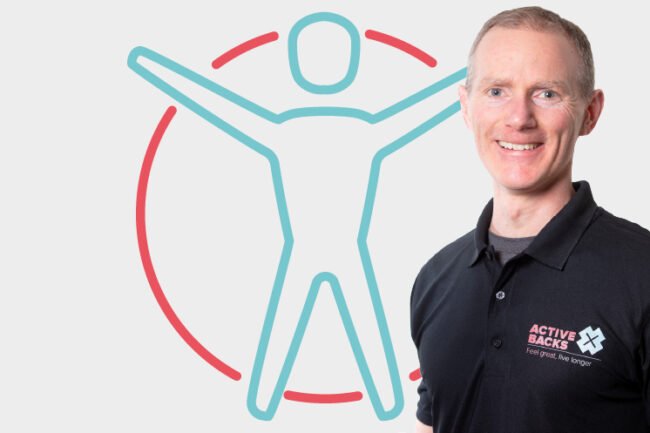How can low back pain be due to stress?
How can low back pain be due to stress?
This episode is entitled “How can low back pain be due to stress?” and it covers:
Pain is a complex sensation. Let’s say someone sticks a pin in your back. What you experienced down at the level of the pin is called nociception. You have little nerve endings called Nociceptors that detect that pin being inserted. They send a message up to the spinal cord. Spinal cord sends a message up to the brain and the brain then interprets all of these sensory input and other input and processes that it has going on and either will give you pain or not.

Stress is a nociception. Nociception is the detection of a noxious substance, in this case of pain, and stress is the detection of psychological stress. If stress is nociception, then distress is pain. We can have stress, but it doesn’t necessarily have to be a thing. Stress goes on in our lives all the time. Even if you, in fact, particularly if you isolate yourself in a little bubble, and have nothing going on that in itself is a stress or, but whether it is distressing to you or not depends on all sorts of factors. Nociception is a physical thing and stress is a psychological thing. Pain is a physically perceived perception. There is a physical perception and distress is a psychological perception perception.
Nociception is a physical, physical input. Stress is a psychological input. Physical pain is a physical sensation and distress is a psychological sensation. Why have I labored through this? Because the two systems have very significant overlap in parts of your brain, and I’m just going to broad brush this and call it the limbic system. It’s all of these centers are not in the limbic system, but we have the amygdala, the thalamus, the hippocampus prefrontal cortex, which is definitely not in your limbic system, but all of these parts of the brain take part in the processing of both physical pain and psychological pain sort of distress. All of these centers are involved in both systems. What does that actually mean at a neuronal level? At a very microscopic level, we can see that when you experience physical pain, there are neurons within nerve cells that light up for what we call fire. They send a little electrical impulses, and those are the same neurons that fire when you experience psychological distress or pain. You literally have the same neurons active in both processes.
All of these neurons, these nerve cells have an electrical lab, a level of electrical activity in the mouth all times. Your nervous system is made up of Watts of electrical impulses, passing along these long, thin nerve fibers. All of these neurons have common purposes or core common uses between psychological pain, distress and physical pain.
Your brain doesn’t have these isolating switches, the electricity is running throughout. Low back pain is experienced when the light bulb in the sitting room, the kitchen and bedroom one all go on at the same time. That’s what penis or again, this is called neural matrix. Every pain experience you have has a specific set of nerve cells, all firing at the same time.
One is back pain. When those light bulbs all go on together, you get back pain. But I don’t know, the stress stress at work, let’s say the distress that you experienced at work, sometimes that experience at a neurological level is equal to the light going on in bedroom, one bedroom, two and the bathroom. I’m gonna struggle to remember all these different rooms. You’ve got that stress going on at work. You’re feeling distressed and that causes bedroom one bedroom, two, and the bathroom lights all to be firing. They’re all firing, but guess what? There’s no isolation between bedroom one, the sitting room and the kitchen lights. Because the bedroom one light is on the sitting room, light comes on and the kitchen light comes on and you experienced back pain.
I don’t know about you, but I’m quite liking this metaphor. It may be making absolutely no sense to you at all, but I’m going to run with it. You can tell, I just made this up on the spot. Let’s go back through that again. You’re experiencing stress at work at a neurological level stress at work equates to the lights and bedroom, one bedroom, two, and the bathroom going on, but because there’s no isolating switch between bedroom one, the sitting room and the kitchen, those lights come on too. And so you experienced back pain at the same time. There is a huge overlap between the different circuits involved in distress, psychological pain and physical pain. That’s how back pain can be due to stress.
This metaphor is a big simplification. There is a bigger overlap between the circuits related to psychological pain, distress and physical pain. And I covered them earlier. The amygdala, the thumbless, the hippocampus, the prefrontal cortex, all of them are involved in both processes. You have these common pathways, and that’s why you may experience more low back pain when you’re under stress than when you are not under psychological stress.
Sometimes with a little bit of prodding, you get that flare up in pain, and you’re not really sure why, because you haven’t done anything different physically. You can’t see what’s triggered it. But then if you think about life as a whole, you’ve got some exams coming up or a family member has become ill or a family member’s coming to visit you, or there’s some kind of psychological stress or active. And that acts as a tremendous volume control on your pain. Stress is only one variable in the pain equation. It isn’t that tress causes your back problem, but it will act as a volume control on the amount of pain that you feel. There are other variables in that pain equation, not least the amount of attention you give things. And of course the other ones being movement, movement is super important.


